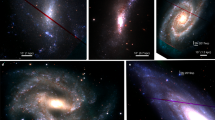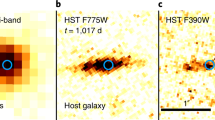Abstract
It is assumed1,2,3 that the radioactive decay of 44Ti powers the infrared, optical and ultraviolet emission of supernova remnants after the complete decay of 56Co and 57Co (the isotopes that dominated the energy balance during the first three to four years after the explosion) until the beginning of active interaction of the ejecta with the surrounding matter. Simulations4,5 show that the initial mass of 44Ti synthesized in core-collapse supernovae is (0.02–2.5) × 10−4 solar masses ( ). Hard X-rays and γ-rays from the decay of this 44Ti have been unambiguously observed from Cassiopeia A only6,7,8, leading to the suggestion that values of the initial mass of 44Ti near the upper bound of the predictions occur only in exceptional cases9. For the remnant of supernova 1987A10,11, an upper limit to the initial mass of 44Ti of <10−3
). Hard X-rays and γ-rays from the decay of this 44Ti have been unambiguously observed from Cassiopeia A only6,7,8, leading to the suggestion that values of the initial mass of 44Ti near the upper bound of the predictions occur only in exceptional cases9. For the remnant of supernova 1987A10,11, an upper limit to the initial mass of 44Ti of <10−3 has been obtained from direct X-ray observations12, and an estimate of (1–2) × 10−4
has been obtained from direct X-ray observations12, and an estimate of (1–2) × 10−4 has been made from infrared light curves and ultraviolet spectra by complex and model-dependent computations13,14,15. Here we report observations of hard X-rays from the remnant of supernova 1987A in the narrow band containing two direct-escape lines of 44Ti at 67.9 and 78.4 keV. The measured line fluxes imply that this decay provided sufficient energy to power the remnant at late times. We estimate that the initial mass of 44Ti was (3.1 ± 0.8) × 10−4
has been made from infrared light curves and ultraviolet spectra by complex and model-dependent computations13,14,15. Here we report observations of hard X-rays from the remnant of supernova 1987A in the narrow band containing two direct-escape lines of 44Ti at 67.9 and 78.4 keV. The measured line fluxes imply that this decay provided sufficient energy to power the remnant at late times. We estimate that the initial mass of 44Ti was (3.1 ± 0.8) × 10−4 , which is near the upper bound of theoretical predictions.
, which is near the upper bound of theoretical predictions.
This is a preview of subscription content, access via your institution
Access options
Subscribe to this journal
Receive 51 print issues and online access
$199.00 per year
only $3.90 per issue
Buy this article
- Purchase on Springer Link
- Instant access to full article PDF
Prices may be subject to local taxes which are calculated during checkout



Similar content being viewed by others
References
Suntzeff, N. B. The energy sources powering the late-time bolometric evolution of SN 1987A. Astrophys. J. 384, L33–L36 (1992)
Clayton, D. D. et al. The 57Co abundance in SN 1987A. Astrophys. J. 399, L141–L144 (1992)
Fransson, C. & Kozma, C. The freeze-out phase of SN 1987A: implication for the light curve. Astrophys. J. 408, L25–L28 (1993)
Thielemann, F.-K., Hashimoto, M. & Nomoto, K. Explosive nucleosynthesis in SN 1987A. II. Composition, radioactivities, and the neutron star mass. Astrophys. J. 349, 222–240 (1990)
Woosley, S. E. & Hoffman, R. D. 57Co and 44Ti production in SN 1987A. Astrophys. J. 368, L31–L34 (1991)
Iyudin, A. F. et al. COMPTEL observations of 44Ti gamma-ray line emission from Cas A. Astron. Astrophys. 284, L1–L4 (1994)
Vink, J. et al. Detection of the 67.9 and 78.4 keV lines associated with the radioactive decay of 44Ti in Cassiopeia A. Astrophys. J. 560, L79–L82 (2001)
Renaud, M. et al. The signature of 44Ti in Cassiopeia A revealed by IBIS/ISGRI on INTEGRAL. Astrophys. J. 647, L41–L44 (2006)
The, L.-S. et al. Are 44Ti-producing supernovae exceptional? Astron. Astrophys. 450, 1037–1050 (2006)
Arnett, W. D., Bahcall, J. N., Kirshner, R. P. & Woosley, S. E. Supernova 1987A. Annu. Rev. Astron. Astrophys. 27, 629–700 (1989)
Imshennik, V. S. & Nadezhin, D. K. Supernova 1987A in the Large Magellanic Cloud: observations and theory. Sov. Sci. Rev. E 8, 1–147 (1989)
Shtykovskiy, P. E., Lutovinov, A. A., Gilfanov, M. R. & Sunyaev, R. A. Constraints on the luminosity of the central source in the SNR 1987A. Astron. Lett. 31, 258–262 (2005)
Chugai, N. N., Chevalier, R. A., Kirshner, R. P. & Challis, P. M. Hubble Space Telescope spectrum of SN 1987A at an age of 8 years: radioactive luminescence of cool gas. Astrophys. J. 483, 925–940 (1997)
Jerkstrand, A., Fransson, C. & Kozma, C. The 44Ti-powered spectrum of SN 1987A. Astron. Astrophys. 530, A45 (2011)
Larsson, J. et al. X-ray illumination of the ejecta of supernova 1987A. Nature 474, 484–486 (2011)
Ahmad, I. et al. Improved measurement of the 44Ti half-life from a 14-year long study. Phys. Rev. C 74, 065803 (2006)
Iyudin, A. F. et al. Emission from 44Ti associated with a previously unknown Galactic supernova. Nature 396, 142–144 (1998)
Borkowski, K. J. et al. Radioactive scandium in the youngest Galactic supernova remnant G1.9+0.3. Astrophys. J. 724, L161–L165 (2010)
Sunyaev, R. A. et al. Discovery of hard X-ray emission from supernova 1987A. Nature 330, 227–229 (1987)
Matz, S. M. et al. Gamma-ray line emission from SN1987A. Nature 331, 416–418 (1988)
Sunyaev, R. A. et al. Hard X-ray radiation from SN 1987A. Roentgen observatory observations from 1987 to 1989. Sov. Astron. Lett. 16, 171–176 (1990)
Winkler, C. et al. The INTEGRAL mission. Astron. Astrophys. 411, L1–L6 (2003)
Berezhko, E. G., Ksenofontov, L. T. & Völk, H. J. Expected gamma-ray emission of supernova remnant SN 1987A. Astrophys. J. 732, 58 (2011)
Sturm, R., Haberl, F., Aschenbach, B. & Hasinger, G. High resolution X-ray spectroscopy of SN 1987A: monitoring with XMM-Newton. Astron. Astrophys. 515, A5 (2010)
Thielemann, F.-K., Nomoto, K. & Hashimoto, M. Core-collapse supernovae and their ejecta. Astrophys. J. 460, 408–436 (1996)
Park, S., Zhekov, S. A., Burrows, D. N. & McCray, R., SNR 1987A: opening the future by reaching the past. Astrophys. J. 634, L73–L76 (2005)
Krivonos, R. et al. INTEGRAL/IBIS 7-year all-sky hard X-ray survey. I. Image reconstruction. Astron. Astrophys. 519, A107 (2010)
Churazov, E. et al. Positron annihilation spectrum from the Galactic Centre region observed by SPI/INTEGRAL revisited: annihilation in a cooling ISM? Mon. Not. R. Astron. Soc. 411, 1727–1743 (2011)
Meaburn, J., Bryce, M. & Holloway, A. J. The kinematics of the rings around SN 1987A. Astron. Astrophys. 299, L1–L4 (1995)
Acknowledgements
We thank R. A. Sunyaev for reading the manuscript and for comments; V. S. Imshennik, D. K. Nadezhin and N. N. Chugai for discussions about aspects of the physics of the supernova 1987A explosion; R. A. Krivonos for information regarding the analysis of INTEGRAL/IBIS data; and M. Coe for allowing us access to his INTEGRAL data of the LMC observations (∼1 Ms) before the end of the proprietary period. This work is based on data obtained through the Russian and European INTEGRAL science data centres, and was supported by grants RFBR-11-02-12285ofi-m-2011 and RAS-P20 ‘The origin, structure and evolution of objects of the Universe’.
Author information
Authors and Affiliations
Contributions
S.A.G. was Principal Investigator of the proposal requesting INTEGRAL time (∼3.5 Ms) to observe SNR 1987A; made a preliminary analysis of the IBIS/ISGRI data and detected an excess at the SNR 1987A position; and wrote a draft of the text. A.A.L. was Co-investigator of the proposal, and participated in the analysis of IBIS/SIGRI data and the verification of the result. S.S.T. carried out the analysis of SPI data. C.W. provided general support for this project and participated in its different aspects, and C.W. and A.A.L. contributed substantially to the final text. All authors discussed the results and their presentation.
Corresponding author
Ethics declarations
Competing interests
The authors declare no competing financial interests.
Rights and permissions
About this article
Cite this article
Grebenev, S., Lutovinov, A., Tsygankov, S. et al. Hard-X-ray emission lines from the decay of 44Ti in the remnant of supernova 1987A. Nature 490, 373–375 (2012). https://doi.org/10.1038/nature11473
Received:
Accepted:
Published:
Issue Date:
DOI: https://doi.org/10.1038/nature11473
This article is cited by
-
Understanding the origin of the positron annihilation line and the physics of supernova explosions
Experimental Astronomy (2021)
-
Nucleosynthesis in Supernovae
Space Science Reviews (2018)
-
Gamma-ray observatory INTEGRAL reloaded
Nature Astronomy (2017)
Comments
By submitting a comment you agree to abide by our Terms and Community Guidelines. If you find something abusive or that does not comply with our terms or guidelines please flag it as inappropriate.



